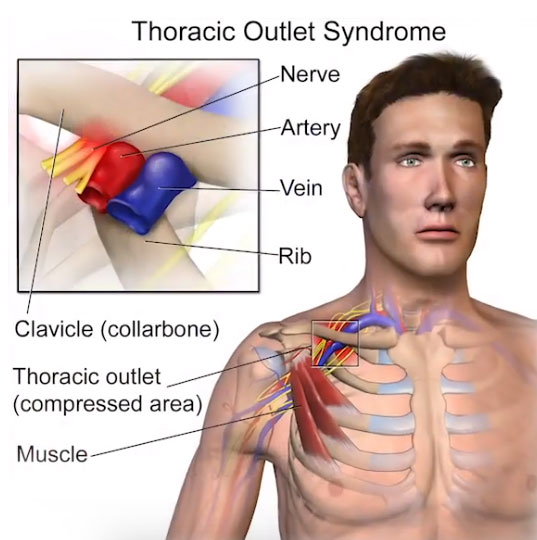What are the symptoms of venous thoracic outlet syndrome?
Venous thoracic outlet syndrome (VTOS) is a condition caused by compression of the veins in the thoracic outlet, the space between the collarbone and the first rib. The symptoms are primarily related to impaired venous return from the arm and can include:
- Swelling: Swelling of the arm, hand, or fingers, which may be more pronounced after activities or at the end of the day.
- Discoloration: The affected arm or hand may appear blue or purplish due to poor blood flow.
- Pain or Discomfort: Pain or a heavy feeling in the arm or shoulder, which may worsen with activity or after prolonged use.
- Numbness or Tingling: Sensations of numbness or tingling in the arm, hand, or fingers.
- Weakness: Muscle weakness in the affected arm or hand.
- Cold Sensation: The affected arm or hand may feel cooler compared to the other side.
Symptoms can vary in intensity and may be triggered or exacerbated by certain positions or activities that compress the thoracic outlet. Early diagnosis and treatment are important to manage symptoms and prevent complications.
What are the causes of venous thoracic outlet syndrome?
Venous thoracic outlet syndrome (VTOS) occurs when there is compression of the veins in the thoracic outlet area, leading to impaired blood flow. Several factors can contribute to this condition:
- Anatomical Abnormalities: Variations in the anatomy of the thoracic outlet, such as an extra rib (cervical rib) or abnormal muscle structures, can lead to compression of the veins.
- Postural Factors: Poor posture or positions that compress the thoracic outlet, such as prolonged overhead activities or excessive use of the arms, can contribute to VTOS.
- Trauma or Injury: Previous trauma or repetitive strain injuries to the shoulder or chest area can cause structural changes or inflammation that compresses the veins.
- Repetitive Strain: Activities that involve repetitive overhead movements or heavy lifting can increase the risk of developing VTOS by stressing the thoracic outlet.
- Tumors: Rarely, tumors or masses in the thoracic outlet area can compress the veins and lead to VTOS.
- Inflammation: Inflammatory conditions affecting the thoracic outlet, such as inflammation of the surrounding muscles or tissues, can contribute to vein compression.
Addressing these underlying causes through proper diagnosis and management is essential for effective treatment of venous thoracic outlet syndrome.
What is the treatment for venous thoracic outlet syndrome?
Treatment for venous thoracic outlet syndrome (VTOS) aims to relieve symptoms, improve venous circulation, and address any underlying causes. The approach often involves a combination of conservative measures and, in some cases, surgical intervention. Here are the common treatment options:
1. Conservative Management:
- Lifestyle Modifications: Avoiding activities that exacerbate symptoms, such as heavy lifting or prolonged overhead positions.
- Posture Correction: Improving posture through physical therapy can help alleviate compression in the thoracic outlet area.
- Physical Therapy: Targeted exercises to strengthen the muscles around the thoracic outlet and improve flexibility can reduce compression. Techniques may include stretching, strengthening, and posture correction exercises.
- Compression Garments: Wearing compression sleeves or stockings to help reduce swelling and improve venous return.
2. Medications:
- Pain Relief: Nonsteroidal anti-inflammatory drugs (NSAIDs) or other pain relievers to manage pain and inflammation.
- Anticoagulants: In cases where there is a risk of blood clots, anticoagulants may be prescribed to prevent clot formation.
3. Surgical Interventions:
- Decompression Surgery: If conservative treatments are ineffective, surgery may be necessary to relieve pressure on the veins. This can involve removing structures that are compressing the veins, such as an extra rib (cervical rib) or scar tissue.
- Venous Reconstruction: In some cases, surgical procedures to repair or reconstruct the affected veins may be needed to restore proper blood flow.
4. Monitoring and Follow-Up:
- Regular Check-Ups: Ongoing monitoring by a healthcare provider to assess the effectiveness of treatment and make necessary adjustments.
Early diagnosis and treatment are crucial for managing venous thoracic outlet syndrome and preventing complications. Consulting with a healthcare provider or a specialist in vascular or thoracic surgery can help determine the most appropriate treatment plan based on individual symptoms and underlying causes.

Leave a Reply
You must be logged in to post a comment.